A video by Mike Headley of the Galveston’s tall ship Elissa on her yearly sail. She is a three-masted barque built in Aberdeen, Scotland and launched in 1877. She is now a museum ship at the Texas Seaport Museum.

Photo: Gergely Torda/ARC Center of Excellence for Coral Reef Studies
The Great Barrier Reef, off Australia’s east coast, is 1,400 miles long, covers 133,000 square miles and can be seen from outer space. It may be dying before our eyes. “We thought the Barrier Reef was too big to fail,” says Professor Andrew Baird, chief investigator at the ARC Center of Excellence for Coral Reef Studies in Australia, “but it’s not.”
Since 2016, half of all coral in the Great Barrier Reef has died. The reef was blanketed by dangerously hot water in the summer of 2016, strangling and starving the corals, causing what has been called “an unprecedented bleaching event.” Then 2017 proved to be almost as bad. The two years was the first back to back bleaching events ever recorded. There are serious concerns that there may be another bleaching event in 2019.
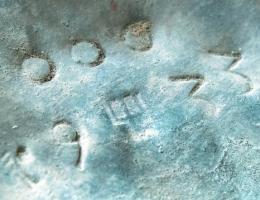
Copper plate bearing Fugger family marks
In early January, we posted about the containership ship MSC Zoe which lost 350 containers over the side in a storm off the Frisian Islands of the Netherlands. Now, a Dutch salvage team, looking for lost containers from the Zoe, has discovered a shipwreck believed to date from around 1540 on the North Sea bottom.
The shipwreck is said to be the oldest sea-going ship ever found in Dutch waters. The ship was loaded with copper plates bearing the symbol of the Fugger family, a merchant banking family based in Augsburg in Germany, which for a time also held a monopoly over copper production. The ship estimated to be 30m by 7m could have been carrying as much as 5,000 kg (five tonnes) of copper.
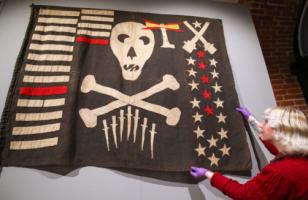
Flag flown by HMS Safari in WW II
The National Museum of the Royal Navy at the Portsmouth Historic Dockyard has a new exhibition — Jolly Roger: A Symbol of Terror and Pride. The website describes the exhibition as telling the story of the skull and crossbones flag, commonly known as the Jolly Roger, which has been associated with pirates for centuries. They also comment that “the history of its use by the Royal Navy who started flying the flag from First World War submarines is lesser known.”
Why did Royal Navy submarines fly pirate flags? Continue reading
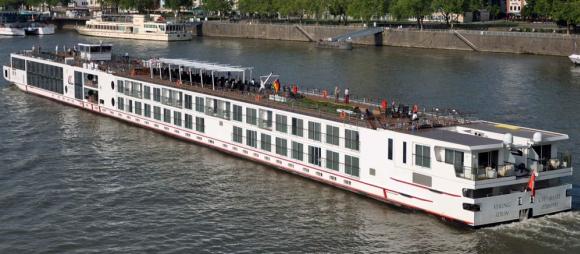 Just after Midnight, on April 1, the river cruiser Viking Idun collided with a laden chemical tanker, Chemical Marketer, in the Netherlands’ Western Scheldt. The river cruise ship was sailing from the port of Antwerp to Ghent while the tanker was bound for Antwerp. Both ships were damaged above the waterline. No pollution was reported resulting from the collision.
Just after Midnight, on April 1, the river cruiser Viking Idun collided with a laden chemical tanker, Chemical Marketer, in the Netherlands’ Western Scheldt. The river cruise ship was sailing from the port of Antwerp to Ghent while the tanker was bound for Antwerp. Both ships were damaged above the waterline. No pollution was reported resulting from the collision.
No injuries were reported aboard the tanker but five people on Viking Idun suffered minor injuries, according to emergency services. Four were passengers, all cared for on board by medical staff. One crew member was transferred to a hospital for closer investigation. 117 passengers were aboard at the time of the collision.
A repost that seems appropriate for the day. They probably shouldn’t have built the gym over the water.
Whale Breaches Before a Basketball Game
Happy April Fool’s Day.
One of the more paradoxical signs of spring along parts of Lake Michigan are the wild and wonderfully weird ice shards which pile up in fantastic geometric patterns along the shoreline. As the lake begins to thaw, water underneath the ice pushes broken sheets up to the surface, forming jagged otherworldly landscapes of jagged ice. Here is a video of photographs taken along the shore of South Haven, MI, by Joel Bissell for MLive.com. Thanks to Irwin Bryan for contributing to this post.
 Are you interested in acquiring a Foxtrot-class Soviet-era submarine? If so, the folks at Urban Commons, the operators of the hotel and tourist attraction Queen Mary in Long Beach may want to talk to you. They have a well-used submarine that they would seriously like to get rid of.
Are you interested in acquiring a Foxtrot-class Soviet-era submarine? If so, the folks at Urban Commons, the operators of the hotel and tourist attraction Queen Mary in Long Beach may want to talk to you. They have a well-used submarine that they would seriously like to get rid of.
The submarine is a diesel-electric patrol submarine that was built in the Soviet Union in 1971. Designated B-427, it served in the Soviet Pacific fleet for 23 years. After decommissioning, she was loaned to Australian National Maritime Museum for display as a museum vessel between 1995 and 19998.
In 1998, the submarine was moved to Long Beach, California and was berthed next to the Queen Mary. The submarine was opened to the public as the “Podvodnaya Lodka B-427 Scorpion.” The submarine was a Long Beach tourist attraction for almost two decades. It was not well maintained, however. In 2012, the submarine partially flooded and in 2016, it was closed to visitors.
 For several months now, scientists have been monitoring growing cracks in Antarctica’s Brunt Ice Shelf which have been spreading at an alarming rate. At almost any time, perhaps even in days, an iceberg over 560 square miles, or twice the size of New York City, is expected to calve from the ice shelf.
For several months now, scientists have been monitoring growing cracks in Antarctica’s Brunt Ice Shelf which have been spreading at an alarming rate. At almost any time, perhaps even in days, an iceberg over 560 square miles, or twice the size of New York City, is expected to calve from the ice shelf.
While the crack was first noted 35 years ago, it was slow moving and the ice shelf has been stable. Recently, however, the crack has started accelerating toward another fissure called the Halloween crack.
“We don’t have a clear picture of what drives the shelf’s periods of advance and retreat through calving,” Chris Shuman, a glaciologist with NASA and the University of Maryland, Baltimore County, said in a statement quoted by USA Today. “The likely future loss of the ice on the other side of the Halloween Crack suggests that more instability is possible.”
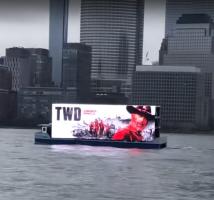 If you happen to have been on the Hudson or East River waterfront in Manhattan recently, there is a good chance that you might have seen a 60′ illuminated digital billboard on a barge passing by close to shore. The billboard features advertising pitching everything from beer to movies to helicopter rides. The company which operates the barge, Ballyhoo Media, considers it to be “the future of digital billboard advertising.” Many New Yorkers consider it to be a nuisance and an eyesore. The City of New York considers the billboard barge to be illegal and has filed a lawsuit to shut it down.
If you happen to have been on the Hudson or East River waterfront in Manhattan recently, there is a good chance that you might have seen a 60′ illuminated digital billboard on a barge passing by close to shore. The billboard features advertising pitching everything from beer to movies to helicopter rides. The company which operates the barge, Ballyhoo Media, considers it to be “the future of digital billboard advertising.” Many New Yorkers consider it to be a nuisance and an eyesore. The City of New York considers the billboard barge to be illegal and has filed a lawsuit to shut it down.
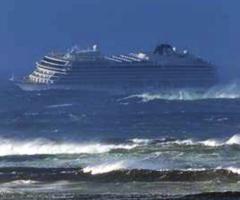 Last weekend, the cruise ship Viking Sky, with over 1,300 passengers and crew aboard, lost all four of its engines in high winds and rough seas off the Norwegian coast and came precariously close to drifting onto a rocky reef. Now the Norwegian Maritime Authority has concluded the engines’ failure “was directly caused by low oil pressure”. All four of the ship’s engines failed but the crew managed to restart one of them just in time.
Last weekend, the cruise ship Viking Sky, with over 1,300 passengers and crew aboard, lost all four of its engines in high winds and rough seas off the Norwegian coast and came precariously close to drifting onto a rocky reef. Now the Norwegian Maritime Authority has concluded the engines’ failure “was directly caused by low oil pressure”. All four of the ship’s engines failed but the crew managed to restart one of them just in time.
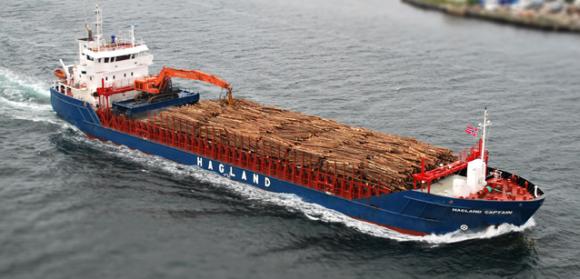 When the Viking Sky lost power in a storm off the coast of Norway this weekend, the 5,000 DWT geared lumber carrier Hagland Captain responded to the distress call and diverted to assist the cruise ship. The lumber carrier, however, would soon also need to be rescued.
When the Viking Sky lost power in a storm off the coast of Norway this weekend, the 5,000 DWT geared lumber carrier Hagland Captain responded to the distress call and diverted to assist the cruise ship. The lumber carrier, however, would soon also need to be rescued.
During the helicopter evacuation of the cruise ship’s passengers, two of the five rescue helicopters were briefly called away to rescue the nine crew of the Hagland Captain. The lumber carrier was roughly 5 NM miles away from the Viking Sky when it too lost power in the storm. The crew was rescued and the ship itself was later towed to safety.
The Haglund Captain is an interesting ship in her own right. Continue reading
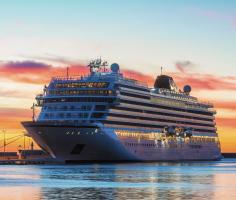
Viking Sky
In early March, a press release announced, “Viking Dominates Cruise Critic’s 2019 Cruisers’ Choice Awards.” Viking’s five 930 passenger ships won ten awards. The Viking Sky received First Place in six award categories within the small to mid-size ship group: Best Overall Ship, Best Cabins, Best Dining, Best for Public Rooms, Best Service and Best Value-for-Money. Viking Sky also beat ships of all sizes to win First Place as Best for First-Timers.
Unfortunately, Viking Ocean Cruises has had its problems. Continue reading

The ship was less than a half a ship-length off the rocks when it was able to anchor.
The cruise ship Viking Sky is now underway bound for the port of Molde, Norway, accompanied by a tug and support vessels. Prior to getting underway, 479 passengers were evacuated by helicopters, leaving 436 passengers and 458 crew members onboard. There are 20 reported injuries.
The ship lost power on Saturday and came perilously close to drifting onto the rocky shore in seas described as 8 meters (26 feet) high and winds of 38 knots. Norwegian Coast Guard officer Emil Heggelund told newspaper VG that the ship was 100 meters (328 feet) from striking an under the water reef and 900 meters (2,953 feet) from shore when was able to anchor in Hustadvika Bay. For context, as the ship is 228 m (748 ft), it was less than a half a ship-length off the rocks before it was able to anchor.
 According to Norwegian authorities, roughly 1,300 people are being evacuated from the cruise ship Viking Sky. The ship suffered engine problems and sent out a distress call and was drifting toward shore in high winds and rough seas off the western coast of Norway.
According to Norwegian authorities, roughly 1,300 people are being evacuated from the cruise ship Viking Sky. The ship suffered engine problems and sent out a distress call and was drifting toward shore in high winds and rough seas off the western coast of Norway.
The Norwegian newspaper VG is reporting that the ship was within 2.5 nautical miles from shore at around 4PM local time. Winds were reported to be around 38 knots with waves up to eight meters high. By 6:30 pm local time, the ship’s personnel were reported to have brought at least one of the ship’s four engines back on-line. By that time, around 100 passengers had been rescued according to Viking operations manager, Tor Andre Franck.
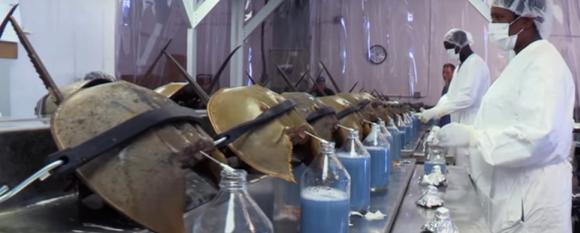 Horseshoe crabs are an ancient variety of arthropods, which are not actually crabs. Having remained largely unchanged in about 450 million years, the horseshoe crab is considered by many to be a living fossil. One of the reasons that horseshoe crabs have survived so long is that they have a highly robust immune system. Indeed, the horseshoe crab’s bright blue blood has remarkable antibacterial properties.
Horseshoe crabs are an ancient variety of arthropods, which are not actually crabs. Having remained largely unchanged in about 450 million years, the horseshoe crab is considered by many to be a living fossil. One of the reasons that horseshoe crabs have survived so long is that they have a highly robust immune system. Indeed, the horseshoe crab’s bright blue blood has remarkable antibacterial properties.
The good news for humans, and the bad news for horseshoe crabs, is that amebocytes in the horseshoe crab blood are highly sensitive to time amounts of bacteria and will coagulate around as little as one part in a trillion of bacterial contamination. Limulus Amebocyte Lysate, or LAL, a compound processed from horseshoe crab blood is used to test for contamination of anything that might go inside the human body: every shot, every IV drip, and every implanted medical device.
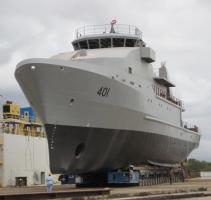 Last month we posted about the successful voyage of the Sea Hunter, a 132′ long autonomous drone trimaran from San Diego to Pearl Harbor, Hawaii, and back. Now USNI News is reporting that the Navy is moving quickly to field an unmanned “Ghost Fleet” — a new breed of armed unmanned surface combatants which will add more sensors and weapons to the current fleet.
Last month we posted about the successful voyage of the Sea Hunter, a 132′ long autonomous drone trimaran from San Diego to Pearl Harbor, Hawaii, and back. Now USNI News is reporting that the Navy is moving quickly to field an unmanned “Ghost Fleet” — a new breed of armed unmanned surface combatants which will add more sensors and weapons to the current fleet.
“These are 200- to 300-foot [vessels], 2,000 tons. I’m not sure what the final hull form will be, that’s what we are using today in terms of what the Ghost Fleet buy will be,” Rear Adm. Randy Crites, deputy assistant secretary of the Navy for budget, said during a press budget briefing.
 On Maryland’s Eastern Shore and in a handful of other ports around the country, there is a sailors’ tradition of burning your socks on the vernal equinox, the first day of Spring. If you have been wearing the same woolen stockings all winter, this may be a good time to commit them to the flames.
On Maryland’s Eastern Shore and in a handful of other ports around the country, there is a sailors’ tradition of burning your socks on the vernal equinox, the first day of Spring. If you have been wearing the same woolen stockings all winter, this may be a good time to commit them to the flames.
As ancient traditions go, this one is pretty new. According to Preservation Maryland, after a particularly snowy winter in 1978, Annapolitan Bob Tuner was anxious to shed his socks with the arrival of spring. He invited his colleagues to celebrate the end of winter by burning their socks after work, a symbolic goodbye to winter as the group of boat builders, sailors, and watermen intended to forgo wearing socks until the cold weather returned; and so a tradition was born.
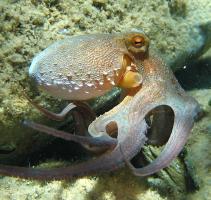 If a science fiction writer wanted to create a really bizarre alien space creature, using an octopus as a model would not be a bad place to start. After all, an octopus has three hearts, nine brains, and blue blood. The nervous system includes a central brain and large brain-like ganglion at the base of each arm which controls movement. The majority of neurons in an octopus are found in the arms, which can independently taste and touch and also control basic motions without input from the brain. An octopus also has the highest brain-to-body mass ratios of any invertebrates; greater than that of many vertebrates, as well. Not surprisingly, octopuses are highly intelligent.
If a science fiction writer wanted to create a really bizarre alien space creature, using an octopus as a model would not be a bad place to start. After all, an octopus has three hearts, nine brains, and blue blood. The nervous system includes a central brain and large brain-like ganglion at the base of each arm which controls movement. The majority of neurons in an octopus are found in the arms, which can independently taste and touch and also control basic motions without input from the brain. An octopus also has the highest brain-to-body mass ratios of any invertebrates; greater than that of many vertebrates, as well. Not surprisingly, octopuses are highly intelligent.
But it gets weirder. Unlike most other living creatures, octopuses, along with some squid and cuttlefish species, routinely edit their RNA (ribonucleic acid) sequences to adapt to their environment. That is RNA, not DNA.
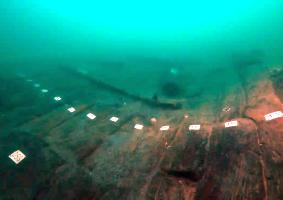
Photo: Christoph Gerigk/Franck Goddio/Hilti Foundation
Six years ago, we posted about the sunken lost city of Thonis-Heracleion in Abu Qir Bay near the Canopic Mouth of the Nile. The city sank into the Mediterranean around 1,2000 years ago and was only rediscovered in 1999. The city dates back roughly 2,700 years and was a major trading port for centuries.
Now marine archeologists have excavated a baris, a type of ship described by the Greek historian Herodotus in the 5th century BCE, from Thonis-Heracleion. The construction of the craft is unique. Here is what Herodotus wrote about the baris:
From [the acacia] tree they cut pieces of wood about two cubits in length and arrange them like bricks, fastening the boat together by running a great number of long bolts through the two-cubit pieces; and when they have thus fastened the boat together, they lay cross-pieces[81] over the top, using no ribs for the sides; and within they caulk the seams with papyrus. Continue reading
